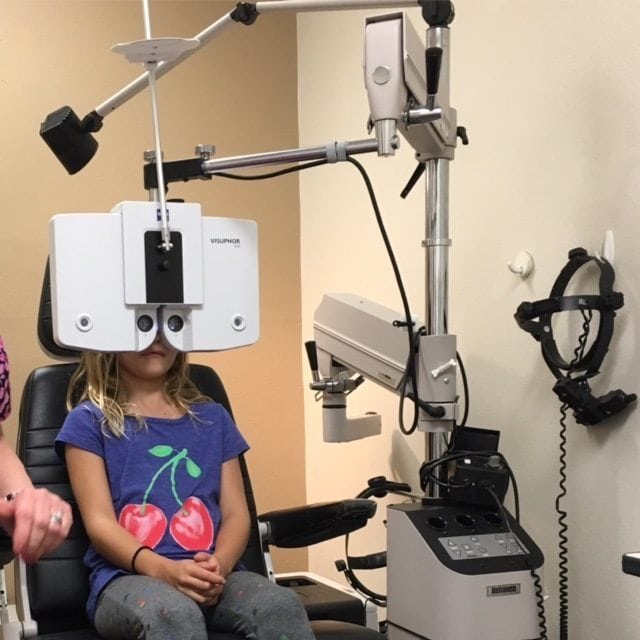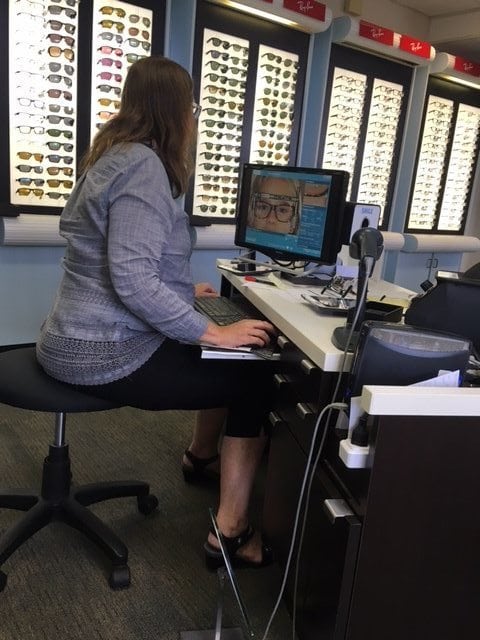 My own father can’t see the big E on the eye chart, yet I was still shocked. Shocked when my pediatrician announced that my oldest failed her eye test at her annual wellness exam. I was standing right there as she missed this letter on one line and that letter on the next. I just figured she may not be 20/20, but she was 20/good enough. I guess my surprise was obvious because the doctor went on to say kids get nervous or confused when they read the chart and that it was probably a fluke. I nodded my head, took her recommendation for a local opthamologist and went on our way.
My own father can’t see the big E on the eye chart, yet I was still shocked. Shocked when my pediatrician announced that my oldest failed her eye test at her annual wellness exam. I was standing right there as she missed this letter on one line and that letter on the next. I just figured she may not be 20/20, but she was 20/good enough. I guess my surprise was obvious because the doctor went on to say kids get nervous or confused when they read the chart and that it was probably a fluke. I nodded my head, took her recommendation for a local opthamologist and went on our way.
Actually, I forgot to schedule the eye exam because my daughter never complained of headaches and never seemed to have trouble seeing anything until she was doing a math assignment on time. At first I thought she was mixing up the hour and minute hands when I heard my pediatrician’s voice in my head saying “it won’t hurt to get her eyes checked.” That’s when it dawned on me that I should really schedule that appointment.
Since neither my husband nor myself have glasses, I was thrust into the great unknown — pardon the cliché, but it’s true — I was the blind leading the blind. Here is a the rundown of what happens when you realize that your child may need glasses.
 The exam. We didn’t have a vision plan, so it made no difference which doctor we chose, but make sure you check your insurance nevertheless. Lucky for us, most offices offer discounts on either the exam, the frames and/or the lenses, so it wasn’t a huge financial burden to be uninsured. The exam is more comprehensive than going to the pediatrician. You must first decide if you want the added cost of dilating the eye for glaucoma; we opted out. The patient then reads the traditional letters for accuracy, but it is done through a computer program that analyzes the patient’s responses to customize the next screen to determine vision acuity. Then both eyes are digitally scanned for shape irregularities (i.e. astigmatism) — holy cow, this newbie learned a lot! Once the patient completes the exam, the opthamologist reviews the results and makes the final determination of glasses or no glasses.
The exam. We didn’t have a vision plan, so it made no difference which doctor we chose, but make sure you check your insurance nevertheless. Lucky for us, most offices offer discounts on either the exam, the frames and/or the lenses, so it wasn’t a huge financial burden to be uninsured. The exam is more comprehensive than going to the pediatrician. You must first decide if you want the added cost of dilating the eye for glaucoma; we opted out. The patient then reads the traditional letters for accuracy, but it is done through a computer program that analyzes the patient’s responses to customize the next screen to determine vision acuity. Then both eyes are digitally scanned for shape irregularities (i.e. astigmatism) — holy cow, this newbie learned a lot! Once the patient completes the exam, the opthamologist reviews the results and makes the final determination of glasses or no glasses.
I prepped my daughter for both scenarios. On the way to the appointment, I told her about all the great people she knew who wore glasses. While we waited for our appointment, we tried on frames. She found a few pairs that she loved and decided she looked good in glasses. It was then I realized that she might actually be brokenhearted if she doesn’t need them. As usual in motherhood, you are damned if you do and damned if you don’t, right?
Shopping for frames. My girl failed the eye exam with flying colors, so we moved on to the frame selection — the fun part! The kids’ selection has come a long way with a wide variety of styles (plastic, metal or frameless, and prices vary from affordable to designer like Prada and Ray-Ban). Be warned that frames aren’t the only thing you pay for, so don’t go all Michael Kors just yet. Lenses are the most important part which means a laundry list of options — glass, plastic or polycarbonate lenses, plus the options of scratch-resistant, anti-glare, UV protection, photochromic, tinted and the list goes on. Talk to the staff about what which frames and lenses will best serve your child’s needs based on their age, how often they’ll be needing to wear glasses etc. Most of the staff wears glasses, so they know best! Don’t forget to ask about any specials they have as well, because we ended up getting half off frames. Score!
 Care and maintenance. Keeping track of glasses and keeping them clean will quickly move to the top of your daily agenda. I recommend a mini bottle of cleaner for the backpack and a regular size one for home. It’s not a bad idea to have some portable lens cleaner for the car, too. Designate a spot in the house where glasses are put every night, because we all know how forgetful our children can be. Some also prefer to have a backup pair; check out Zenni Optical for a less expensive option and ask your provider if they offer an insurance plan. We pay less than $10 a month, and if her glasses break or get lost, we can replace them for $25. Also don’t forget to get them tightened every month, which is usually free. Cases are a must and get more than one, because even with the best intentions your child will inevitably leave home without it.
Care and maintenance. Keeping track of glasses and keeping them clean will quickly move to the top of your daily agenda. I recommend a mini bottle of cleaner for the backpack and a regular size one for home. It’s not a bad idea to have some portable lens cleaner for the car, too. Designate a spot in the house where glasses are put every night, because we all know how forgetful our children can be. Some also prefer to have a backup pair; check out Zenni Optical for a less expensive option and ask your provider if they offer an insurance plan. We pay less than $10 a month, and if her glasses break or get lost, we can replace them for $25. Also don’t forget to get them tightened every month, which is usually free. Cases are a must and get more than one, because even with the best intentions your child will inevitably leave home without it.

Hey, four eyes! No need to worry about your child being teased because glasses are in! My girl’s friends LOVED her new look. In fact, my youngest is crossing her fingers and toes that she will need them in the very near future. Also give the teachers a heads up that your child will be wearing them to make sure they don’t have stage fright at school. Plus, a compliment from your favorite teacher on your new specs is just what some kiddos need. It took her less than a week to get in the habit of wearing them, and she did deal with a little dizziness as her eyes adjusted to the prescription. Other than that, getting glasses is one of the easiest things we’ve ever done!

















If your child has vision problems that don’t allow correction to 20/20 and they are diagnosed with a visual impairment or legal blindness, be sure to contact the Florida Division of Blind Services. There are many state funded and comprehensive rehabilitation services from infancy through adulthood. For kids aged 14+, you can contact the Vision Education and Rehab Center and see about enrolling in the Transition program, which prepares young adults with visual impairment for college, work, and independent living free of charge!